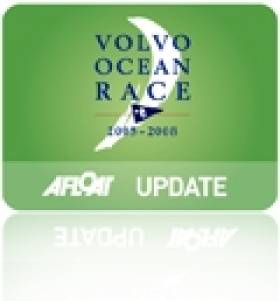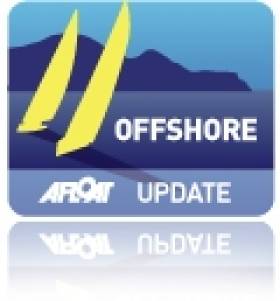Displaying items by tag: United States
Newport Makes It Six For VOR 2014-15 Host Ports
#VOR - Newport in Rhode Island has been announced as the latest stopover for the next edition of the Volvo Ocean Race in 2014-15.
The popular sailing base in the 'Ocean State' will be the North American port on the race route for its 12th running as the end point of the leg from Itajaí in Brazil, and is hosting the event for the first time.
"It's about time the race came to the city of Newport and we are looking forward to a real festival that will delight and inspire sailing fans and those who are new to the sport," said Volvo Ocean Race CEO Knut Frostad at the announcement.
Conveniently located between the Irish-American hotspots of New York City and Boston, the crowds in attendance are sure to feature a prominent 'green' element.
As reported at the weekend on Afloat.ie, Gothenburg in Sweden has been awarded the honour of hosting the VOR finale, much to the disappointment of Galwegians after last summer's successful event.
Top Ten Boat Names in America Make for Amusing Reading
#BOAT NAMES - The Boat Owners Association of the United States (BoatUS) has released its 22nd annual list of the top ten boat names in America, which makes for some amusing reading.
“A boat name reflects the life and loves of the owner,” says BoatUS's Occoless Trotter. “But it’s hard to sum it all up with just a few words.”
Word play seems to be the biggest attraction for new boat owners in the US. Number one for 2011 is 'Seas the Day', which has appeared in the list for the last number of years, followed by newcomer 'Nauti Boy'.
However, Tom Lochhaas at About.com Sailing says the results should be taken with a pinch of salt, as the list is based only on sales of BoatUS's own lettering kits, and does not distinguish between sailboat and powerboat names ('Aquaholic', anyone?).
He also suggests taking a day or two "to calm down before choosing a boat name, which may serve functions other than giving a chuckle to your fishing buddies when they see you at the dock."
The BoatUS Top Ten Names for 2011:
- Seas the Day
- Nauti Buoy
- Aquaholic
- Dream Weaver
- Pegasus
- Serenity Now
- Second Wind
- Liquid Asset
- Miss Behavin'
- Blew ByYou
Middle Sea Race Starts on Saturday
Flying into Malta it's hard not to be struck by the landscape: the buildings all a blinding beige in the hot sun, the landscape fairly arid and dry. It's more reminiscent of the Northern African coast, which is only 155 nautical miles west. The island archipelago is at the crossroads of the Mediterranean situated, as it is, midway between Sicily and the coast of Tunisia. This year's fleet reflects that more than any year past, with numerous entries from throughout Europe, Russia, the United Kingdom and the United States.
One Irish boat, Legally Brunette, from Dun Laoghaire is entered in to the race.
This 31st edition of the 606-nautical mile Rolex Middle Sea Race begins this Saturday, 23 October from Grand Harbour. Registration closes on Friday, but by press time there were 83 boats entered from 18 countries. Included in this number and back to defend, are 2009 Overall Winner, Andres Soriano on the 21-metre mini-maxi Alegre (GBR), and Line Honours winner, Mike Slade on the 30.5-metre ICAP Leopard (GBR).
The race is organized and hosted by the Royal Malta Yacht Club, which moved into stylish brand new quarters overlooking Marsamxett Harbour, just prior to last year's race. The yacht club, with as rich and varied a history as this island republic, is one of the most hospitable anywhere and provides all sailors who make the effort to trek here, a warm welcome.
Yesterday, a low pressure system that swept through south of Sicily, with winds of 50 knots and 3 to 4 metre seas, which has delayed the arrival of some of the foreign fleet. Though some like Esimit Europa 2 (SLO) and Wild Joe (HUN) were already committed to crossing and so endured the conditions encountered enroute. The 30-metre Esimit had a lightening strike that took out the wind instruments at the top of its 44-metre mast. Meanwhile, Marton Jozsa's Wild Joe, a R/P Custom 60, which set out from Croatia on Friday, and then from Sicily yesterday morning, had a tough crossing, ripping both their mainsail and jib.
Many of the fleet is moored in Camper & Nicholson's Grand Harbour Marina and dockside there today there was a flurry of activity with crews effecting repairs or otherwise prepping for Saturday's offshore race. Tomorrow, Wednesday, there will be Coastal Race most likely around neighboring Comino Island. Some boats, though not all, use this race as a tune-up for the offshore.
Along the quay, there were country flags on the back of boats from Spain, Italy, Hungary, Slovenia, the UK and United States, as well as a local fleet of competitors from Malta. One would think the Maltese might have an edge – local knowledge of the area, perhaps – and in that group one of the ringers may well be Jaru (MLT), a J/133 co-skippered by John Ripard Jr. and his brother-in-law, Andrew Calascione. The close relations don't stop there, as half the crew are composed of their children, with a few close friends from the UK there to round out the crew.
Sailing onboard, as helmsman and watch leader, is 23-year old, Sebastian Ripard. This youngest of the Ripard generation is taking time out from his, and team mate Benji Borg's, campaign in the 49er class for the 2012/2016 Olympics. This 600+ mile race requires switching gears from 'around the cans'. Asked what he likes about this, his eighth, race, Sebastian said, "It's a beautiful race. I mean one of the marks is a volcano, which is often erupting! There's always a bit of everything in this race, tactically there are a lot of different points where the race compresses, so there's a lot of tricky areas: the Straits (of Messina), Stromboli, by Favignana, which make it challenging throughout. There are a lot of variables that keep on changing. And I quite enjoy the mental demands of an offshore race; it's more of an adventure. In his first go round in 2002, he racked up an overall win on the J/109 Jammin' (MLT) with – same as this year – his father and uncle. He followed that with a 2nd place in the J/109 Artie (MLT) with Lee Sartariano.
The J-Boat has a good track record for the race: a J/133 won its' class and placed 2nd overall in the 2008 Rolex Middle Sea Race. The 43-footer was Sailing World magazines' "Boat of the Year" award when it was launched in 2003 and the design has proven itself for performance cruising and offshore racing.
Almost all foreign competitors seem drawn to this unique race: a long offshore, anti-clockwise around Sicily, a few volcanoes, and some neighboring islands. Bryon Ehrhart owner and skipper of Lucky (USA), is one of those. Ehrhart, from Chicago, first raced the boat in the 2006 Newport Bermuda Race. Since then they have competed in the 2007 Transpac Race, the 2008 Chicago Mackinac, and the 2009 Rolex Fastnet Race.
His crew are a group of strong amateurs, with a few professionals that have sailed together for years. For the most part, they are Etchells (one-design) sailors, and plan to bring that level of intensity and competitiveness from the small boat fleet to a big boat offshore program.
Ehrhart said, "We have an interest in doing the truly great ocean races and certainly the Rolex Middle Sea Race is one of them. It's a race that I have read about over the years and have thought that – because of the course – would be strategically and tactically challenging, maybe even the most challenging we have done or will ever do.
"A fantastic amount of preparation has gone into getting the boat ready for this race and we hope we are up to all that we may encounter. We have converted this TP52 to an IRC offshore boat. We do a couple of big events a year and this race is the only offshore event we are doing in 2010: it is a race of the quality that is worth organizing our year around. "
Thursday is a Crew Party at the Royal Malta Yacht Club, and on Friday there will be Skipper's race and weather briefing. The Rolex Middle Sea Race commences on Saturday, 23 October 2010. The final prize giving is on Saturday, 30 October. George David's Rambler (USA) established the current Course Record of 47 hours, 55 minutes, and 3 seconds in 2007.
































































